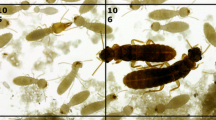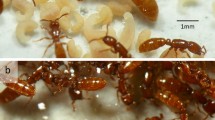Summary
Results of laboratory-based ethological studies on twoNothomyrmecia macrops colonies with individually marked workers are reported. Interactive behavioural acts constituted less than 1% of all those recorded, revealing a strong tendency by the ants not to engage in social contact. Very few workers performed queen-directed acts. They stayed near the queen, though seldom in direct contact. Division of labour was otherwise barely apparent, except that some individuals showed a propensity to guard the nest entrance. No exchange of food was observed between workers, workers and queen, or adults and larvae (apart from worker placement of prey items with larvae). A queen fed from aDrosophila carcass retrieved from the nest floor, without assistance from workers. Systematic scanned observations confirmed levels of inactivity higher than previously observed in ants (comprising almost 2/3 of recorded behavioural acts). The time budget for activities directed toward the immature stages was the same in both colonies, and fluctuated during the circadian period. Non-nestmate larvae added to worker groups were more frequently licked than nestmate larvae, but this might not involve the particular recognition of nestmateversus non-nestmate brood. These observations support the hypothesis thatNothomyrmecia is primitively eusocial, and of special significance in myrmecology.
Similar content being viewed by others
References
Andersson, M., 1984. The evolution of eusociality.Ann. Rev. Ecol. Syst. 15:165–189.
Bartell, R., 1985. The Dinosaur ant.Bogong, March–April 1985 10–12.
Bertin, J., 1977.La graphique et le traitement graphique de l'information. Flammarion, Paris.
Billen, J. P. J., 1988. Comparaison entre les fourmis Australiennes des genresMyrmecia etNothomyrmecia.Actes Coll. Ins. Soc. 4:27–33.
Billen, J. P. J., 1990. The sting bulb gland inMyrmecia andNothomyrmecia (Hymenoptera: Formicidae): a new exocrine gland in ants.Int. J. Insect Morphol. & Embryol. 19:133–139.
Billen, J. P. J., B. D. Jackson and E. D. Morgan, 1988. Secretion of the Dufour gland of the antNothomyrmecia macrops (Hymenoptera: Formicidae).Experientia 44:715–719.
Bolton, B., 1990. Army ants reassessed: the phylogeny of the doryline section (Hymenoptera, Formicidae).J. Nat. Hist. 24:1339–1364.
Brown, W. L., 1954. Remarks on the internal phylogeny and subfamily classification of the family Formicidae.Ins. Soc., 1:21–31.
Brown, W. V., P. Jaisson, R. W. Taylor and M. J. Lacey, 1990. Novel internally branched, internal alkenes as major components of the cuticular hydrocarbons of the primitive Australian antNothomyrmecia macrops Clark (Hymenoptera: Formicidae).J. Chem. Ecol. 16:2623–2635.
Corbara, B., D. Fresneau and J.-P. Lachaud, 1986. An automated technique for behavioural investigations of social insects.Behav. Process. 13:231–249.
Corbara, B., J.-P. Lachaud and D. Fresneau, 1989. Individual variability, social structure and division of labour in the ponerine antEctatomma ruidum Roger (Hymenoptera: Formicidae).Ethology 82:89–100.
Crosland, M. W. J., R. H. Crozier and E. Jefferson, 1988. Aspects of the biology of the primitive ant genusMyrmecia F. (Hymenoptera: Formicidae).J. Aust. ent. Soc. 27:305–309.
Dantas de Araujo, C., D. Fresneau and J. P. Lachaud, 1988. Premiers résultats sur l'éthologie d'une fourmi sans reine:Dinoponera quadriceps.Actes Coll. Ins. Soc. 4:149–155.
Freeland, J., 1958. Biological and social patterns in the Australian bulldog ants of the genusMyrmecia.Aust. J. Zool. 6:1–18.
Fresneau, D., 1984. Développement ovarien et statut social chez une fourmi primitive:Neoponera obscuricornis (Hym., Formicidae, Ponerinae).Ins. Soc. 31:387–402.
Fresneau, D. and A. Charpin, 1977. Une solution photographique au problème du marquage individuel des petits insectes.Ann. Soc. Entomol. Fr. (N.S.) 13:1–5.
Fresneau, D. and P. Dupuy, 1988. A study of polyethism in a ponerine ant:Neoponera apicalis (Hymenoptera: Formicidae).Anim. Behav. 36:1389–1399.
Haskins, C. P. and R. M. Whelden, 1954. Note on the exchange of ingluvial food in the genusMyrmecia.Ins. Soc. 1:33–37.
Hölldobler, B. and R. W. Taylor, 1983. A behavioral study of the primitive antNothomyrmecia macrops Clark.Ins. Soc. 30:384–401.
Hölldobler, B. and E. O. Wilson, 1990.The Ants. Springer-Verlag, Berlin.
Imaï, H. T., R. W. Taylor, M. Kubota, K. Ogata and M. Y. Wada, 1991. Notes on the remarkable karyology of the primitive antNothomyrmecia macrops Clark, and of the related genusMyrmecia Fabricius (Hymenoptera: Formicidae).Psyche, Camb. 97:133–140.
Jaisson, P., D. Fresneau and J. P. Lachaud, 1988. Individual traits of social behavior in ants. In:Interindividual Behavioral Variability in Social Insects (R. L. Jeanne, Ed.), Westview Press, Boulder, pp. 1–51.
Jaisson, P. F. Nicolosi, R. W. Taylor, D. Fresneau and A. Lenoir, 1991. Distance to the nearest neighbour and workers' specialization along the evolution of primitive ants.Proc. JSPS-CNRS Seminar ‘Evolution of Animal Social Behaviour’, Inuyama, Japan, pp. 5–7.
Kugler, C., 1980. The sting apparatus in the primitive antsNothomyrmecia andMyrmecia.J. Aust. ent. Soc. 19:263–267.
Lachaud, J. P., D. Fresneau and B. Corbara, 1988. Mise en évidence de sous-castes comportementales chezAmblyopone pallipes.Actes Coll. Ins. Soc. 4:141–147.
Pérez Bautista, M., J. P. Lachaud and D. Fresneau, 1985. La división del trabajo en la hormiga primitivaNeoponera villosa (Hymenoptera: Formicidae).Fol. Entomol. Mex. 65:119–130.
Rubin, M., J. P. Lachaud and D. Fresneau, 1989. La structure sociale chezEctatomma quadridens: comparaison au sein du genreEctatomma.Actes Coll. Ins. Soc. 5:265–273.
Sakagami, S. F. and Y. Maeta, 1977. Some presumably presocial habits of JapaneseCeratina bees, with notes on various social types in Hymenoptera.Ins. Soc. 24:319–343.
Taylor, R. W., 1978.Nothomyrmecia macrops: A living-fossil ant rediscovered.Science 201:979–985.
Taylor, R. W., 1991.Myrmecia croslandi sp.n., a karyologically remarkable new Australian bulldog ant (Hymenoptera: Formicidae: Myrmeciinae).J. Aust. ent. Soc. 30:288.
Traniello, J. F. A., 1970. Caste in a primitive ant: absence of age polyethism inAmblyopone.Science 202:770–772.
Villet, M. H., 1990a. Division of labour in the Matabele antMegaponera foetens (Fabr.) (Hymenoptera: Formicidae).Ecol. Ethol. Evol. 2:397–417.
Villet, M. H., 1990b. Social organization ofPlatythyrea lamellosa (Roger) (Hymenoptera: Formicidae): II. Division of labour.S.-Afr. Tydskr. Dierk. 25:254–259.
Ward, P. and R. W. Taylor, 1981. Allozyme variation, colony structure and genetic relatedness in the primitive antNothomyrmecia macrops Clark (Hymenoptera: Formicidae).J. Aust. ent. Soc. 20:177–183.
Wilson, E. O., 1971.The Insect Societies. Belknap/Harvard University Press, Cambridge, MA.
Wilson, E. O., 1976. A social ethogram of the neotropical arboreal antZacryptocerus varians (F. Smith).Anim. Behav. 24:354–363.
Author information
Authors and Affiliations
Rights and permissions
About this article
Cite this article
Jaisson, P., Fresneau, D., Taylor, R.W. et al. Social organization in some primitive Australian ants. I.Nothomyrmecia macrops Clark. Ins. Soc 39, 425–438 (1992). https://doi.org/10.1007/BF01240625
Received:
Revised:
Accepted:
Issue Date:
DOI: https://doi.org/10.1007/BF01240625




